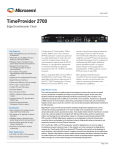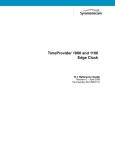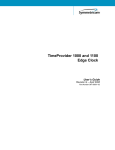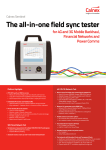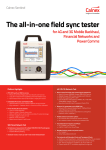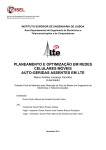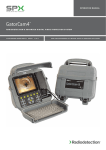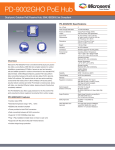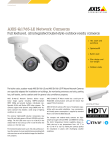Download TimeProvider 2300 Datasheet
Transcript
DATA SHEET TimeProvider 2300 Edge Boundary Clock Key Features •Standalone IEEE 1588 Precision Time Protocol Boundary Clock •Flexible PTP profiles to support both frequency and phase synchronization •ITU-T G.8275.1 Phase/Time Synchronization using forwardable address* •Designed to meet the future ITU-T G.8275.2 profile for phase synchronization •Support for 8 to 128 (optional) PTP clients •Gigabit Ethernet interfaces •Synchronous Ethernet, input and output •E1/T1, input or output (option) •10 MHz, PPS and TOD output •DC or AC power models • OCXO or rubidium holdover oscillator models • Local and remote CLI, web interface, SNMP traps •TimePictra Synchronization Management System support Key Benefits •No change out or upgrade of network hardware •Mitigates impact of backhaul noise, packet delay variation and load asymmetry •Synchronization protection for high network availability •Preserves current MPLS network engineering Major Applications •LTE-FDD, LTE-TDD, LTE-A networks •Ethernet backhaul networks This “synchronization overlay” solution is made possible by features not typically found in integrated boundary clock designs. Using Microsemi’s advanced PTP client software and adaptive timing calculations, these capabilities include superior clock recovery algorithms that determine the best timestamps on which to base the offset calculation, the ability to mitigate for timing impairments, faster clock recovery times, the ability to adapt for load asymmetry, and the ability to leverage frequency input from SyncE or E1/T1 signals. The TimeProvider 2300 also offers the opportunity to upgrade the reference oscillator to extend the holdover time in the event input signals are lost. TimeProvider 2300 supports from 8 to 128 PTP clients, and offers additional output capabilities that allow it to support legacy frequency timing applications, including E1/T1, 10 MHz, pulse per second (PPS) and time of day (TOD). When deployed in an end to end network with Microsemi’s TimeProvider 5000 PTP Grandmaster and TimePictra® Synchronization Management System, carriers can also benefit from superior monitoring information and management capabilities. .. .. .. .. .. .. .. .. .. .. .. .. .. .. .. .. .. .. .. .. .. .. .. .. .. .. .. .. .. .. .. .. .. .. .. .. .. .. .. .. .. .. .. .. .. .. .. .. .. .. •Sync solution for the mobile network edge: 4G/LTE and small cells The Microsemi® TimeProvider® 2300 is an advanced, standalone IEEE 1588 Precision Time Protocol (PTP) Boundary Clock optimized to enable deployment of small cells and meet the stringent timing and synchronization requirements of 4G/LTE networks. It is designed for deployment at selected locations in the backhaul network following the approach anticipated in the proposed ITU-T G.8275.2 standard for partial on-path support. This approach enables timing from a centrally located grandmaster to be maintained over currently deployed network equipment— eliminating the need to upgrade every element to include a PTP boundary clock function. Edge Master Clocks The continuing evolution of mobile network technologies has driven the need for increased accuracy and greater availability of timing and synchronization signals. At the same time, backhaul networks with high packet delay variation present timing “jitter variation” and asymmetry challenges that are difficult to solve with current solutions. Furthermore, deploying a GNSS receiver at every location is impractical, particularly in many small cell environments. Together, these issues create the need for a new overall Synchronization Distribution Architecture for LTE networks. Edge Master clocks are PTP synchronization equipment designed for deployment in current networks by locating a grandmaster at or near the edge or by overlaying the network with advanced boundary clocks at designed locations. They enable mobile network transitions to include small cells, and they support the stringent LTE-TDD and LTE-A phase and time requirements without overhauling the current backhaul network. In frequency synchronized networks (LTE-FDD, as well as 2G/3G), Edge Master equipment can be deployed to eliminate timing issues caused by diverse technologies in the backhaul network, high packet delay environments, and asymmetry inherent in Carrier Ethernet networks. The TimeProvider 2300 is an advanced standalone PTP boundary clock for deployment at planned locations to support precision time distribution over Ethernet backhaul networks. Also included in the Edge Master category, Microsemi’s TimeProvider 2700 is a PTP grandmaster deployed at or near the edge of the network. Together, Edge Master products enable synchronization distribution solutions that allow the mobile network to continue to evolve without retrofit of existing backhaul equipment and without changes to current network design and switching/routing policies. Page 1 of 6 DATA SHEET TimeProvider 2300 Meeting Stringent Synchronization Accuracy Requirements Synchronization accuracy requirements have gone from relatively routine frequency specifications (16 ppb on the network side, 50 ppb for the air interface) to more stringent time and phase requirements as tight as ±5 µsec or even ±1.5 µsec in some of the proposals under discussion in the standards bodies. Global Navigation Satellite System (GNSS) receivers co-deployed or integrated into the mobile base stations are not always a feasible solution for either technical or economic reasons (satellite visibility and antenna deployment costs for example). Primary Reference Time Clock performance, specified by ITU-T G.8272, meets the accuracy requirements using a GNSS signal (GPS or GLONASS) as a reference, and the IEEE 1588 Precision Time Protocol can deliver the needed accuracy under the right conditions. CORE AGGREGATION .. .. .. .. .. .. .. .. .. .. .. .. .. .. .. .. .. .. .. .. .. .. .. .. .. .. .. .. .. .. .. .. .. .. .. .. .. .. .. However backhaul networks with many hops and asymmetric paths between the grandmaster and the PTP client, or networks with multiple transport technologies, or those with high packet delay variation due to loading or other issues, cannot be sure to consistently meet the required specifications. One solution is to upgrade the backhaul network for Synchronous Ethernet and include a PTP boundary clock in every transport element. This is the approach in ITU-T G.8275.1 with full timing on path support from the network. This solution requires that every network element between the grandmaster and the client support Synchronous Ethernet and include a boundary clock function—a solution that is not always feasible due to the high cost to upgrade a network or because the mobile carrier employs 3rd party networks for backhaul. .. .. .. .. .. .. .. .. .. .. .. .. .. .. .. .. .. .. .. .. .. .. .. .. .. .. .. .. .. .. .. .. .. .. .. .. .. .. .. Furthermore, operating at Ethernet Layer 2, G.8275.1 may obsolete or conflict with the current MPLS network design and provisioning policies of the current backhaul network. A better solution is to deploy an Edge Master class of product, using the approach proposed in G.8275.2. Figure 1 depicts TimeProvider 2300 deployments at planned locations. This deployment mitigates or eliminates issues introduced by the performance of the backhaul, and therefore, makes unnecessary the need to upgrade the entire backhaul network to include boundary clocks in every network element. Operating over existing networks at Layer 3, this solution also preserves current MPLS and other network provisioning policies and engineering practices, and it is compatible with and leverages previous investment in using the G.8265.1 profile (and pre-standard profile) for frequency synchronization. ACCESS Rb Time Pictra T imeP r ovider 2300 TimeProvider 5000 Rb Macro eNodeB Rb TimeProvider 2700 TimeProvider 2300 Small Cell Aggregation TimeProvider 5000 .. .. .. .. .. .. .. .. .. .. .. Metro Small Cells Figure 1: Synchronization overlay using advanced PTP boundary clocks. TimeProvider 2300 Boundary Clocks are deployed in engineered locations to support accurate time delivery across the backhaul network, or where GNSS is either not available (urban canyons, subways) or not practical to deploy. The Microsemi TimeProvider 5000 and TimeProvider 2700 Grandmaster clocks integrate G.8272 compliant Primary Reference Time Clock capability. Rubidium oscillators, either in the base stations or the PTP Edge Master Clock, extend the holdover period when the primary reference is lost. In the boundary clock, investment in the high grade oscillator is leveraged across multiple base stations. The TimePictra Synchronization Management System provides remote management of the synchronization equipment and visibility of all PTP clients. Page 2 of 6 DATA SHEET TimeProvider 2300 GNSS (GPS and GLONASS) and Small Cells Integrated GNSS receivers are a viable alternative for timing of macro eNodeB equipment, though operations would still be jeopardized by the well publicized vulnerabilities of GNSS systems, and so using network distributed synchronization at least for backup is considered best practice. Metro or public access small cells present new challenges for synchronization. They require tight timing accuracy, but are often deployed in locations where adequate GNSS signal reception is not feasible: indoors, tunnels and urban canyons for example. TimeProvider 2300 is designed for cost effective deployment at small cell aggregation sites. From this location most small cell backhaul links can support distribution of PTP timing to small cell base stations. Should the small cell backhaul links themselves include many hops or high packet delay variation (PDV), the problem can be solved by deploying an advanced boundary clock at selected small cell network nodes. Protected Synchronization As tighter synchronization becomes more essential to the normal operation of the network (Inter-Cell Interference Coordination, for example) the negative impact of loosing synchronization becomes more significant. Rubidium oscillators provide a way to protect synchronization by delivering best-inclass holdover performance (phase timing of ±1.5 µsec for up to 24 hours). Often seen as expensive upgrades for individual macro base stations, rubidium oscillators in an advanced boundary clock are now more affordable as their cost is amortized across an entire cluster of small cells and co-located macro base stations. .. .. .. .. .. .. .. .. .. .. .. .. .. .. .. .. .. .. .. .. .. .. .. .. .. .. .. .. .. .. .. .. .. .. .. .. .. .. .. .. .. .. .. .. .. .. .. .. .. .. .. .. .. .. .. .. .. .. .. .. .. .. .. .. .. .. .. .. .. .. .. .. .. .. .. .. .. .. .. .. .. .. .. .. .. .. TimeProvider 2300 Equipment The TimeProvider 2300 PTP Boundary Clock provides two gigabit Ethernet interfaces in a combo port configuration supporting use of either copper or optical connections. They are configured as one PTP input port and one PTP output port. Synchronous Ethernet is supported on both ports. Models and options are available to support 8, 16, 32, 64, or 128 PTP clients; all operating at the full 128 messages per second rate. Client capacity can be increased in the field with software license options. The TimeProvider 2300 is available with either an OCXO or rubidium oscillator; each delivering a different level of phase and frequency holdover performance and allowing operators to better optimize their network SLAs. The TimeProvider 2300 includes a programmable 10 MHz or 1 PPS BNC port and a PPS+TOD RS422 on an RJ45 connection. Models with either dual DC or a single AC power input are available. Using passive cooling, the TimeProvider 2300 has no fans. TimeProvider 2300 Software License Options Licensed software options for the TimeProvider 2300 include: Greater client capacity: PTP client capacity in deployed units can be increased to 16, 32, 64, or 128 clients, allowing network engineers to design for capacity they need today and be protected for increased requirements in the future. E1/T1 Input/Output: The E1/T1 software option activates this port for use as either an input or output. As an input the signal provides a frequency reference to the clock function. As an output it can be used for synchronization of equipment using this established timing reference. Default Profile: Enables layer 3 multicast capabilities for operation in additional network scenarios. .. .. .. .. .. .. .. .. .. .. .. .. .. .. .. .. .. .. .. .. .. .. .. .. .. .. .. .. .. .. .. .. .. .. .. .. .. .. .. .. .. .. .. .. .. .. .. .. .. .. .. .. .. .. .. .. .. .. .. .. .. .. .. .. .. .. .. .. .. .. .. .. .. .. .. .. .. .. .. .. .. .. .. .. .. .. Deployment of 4G/LTE networks and small cells present new technical and economic issues for network planners and engineers. A major challenge is to meet stringent timing requirements over backhaul paths that were not originally designed to deliver synchronization at the level of accuracy needed. Upgrading the backhaul network or deploying GNSS receivers at every base station and small cell is often not possible for technical or economic reasons. A new type of synchronization equipment is needed: the TimeProvider 2300 PTP Boundary Clock and its companion product, the TimeProvider 2700 PTP Grandmaster, enable synchronization architectures that are more feasible for many network scenarios. Page 3 of 6 DATA SHEET TimeProvider 2300 Specifications INTERFACES 1 AC power model, IEC 60320 C14 socket .. .. 1 DC power model, dual -48 VDC terminal block .. .. 1 Reset button .. 1 RS232 serial console port, (57,600 bps), DB9 .. .. 1 Gigabit Ethernet – Management port .. - Shielded RJ45, 100/1000 BaseT Ethernet .. .. 2 Gigabit Ethernet – PTP/SyncE input and output combo ports support either: .. - Shielded RJ45, 100/1000 BaseT Ethernet .. .. - SFP (optical), 1000 BaseX .. One combo port is reserved for use as a PTP input (client) and the other combo .. .. port is reserved for use as a PTP output (master) .. 1 E1 or T1 input or output, software configurable, shielded RJ45 (option) .. .. - G.703/9, G.823/G.824 sync interface compliance .. 1 Time of Day (TOD) output port, RS422 Data (9600 Baud) with pulse per second .. (PPS) .. .. signal, shielded RJ45 .. 1 10MHz or 1 PPS output port, BNC (f) .. .. 2 Grounding lugs .. .. IEEE 1588-2008 PTP OUTPUT .. • PTP output client capacity: 8 in basic models, options for 16, 32, 64, or 128 .. clients .. • Up to 128 messages per second per client .. .. • 1-step and 2-step clock .. .. • PTP profiles .. - ITU-T G.8265.1 (layer 3 unicast, IPv4) .. .. - Telecom-2008 Profile (layer 3 unicast, pre-standard ITU-T G.8265.1, IPv4) .. - Ethernet-Default Profile (layer 2 multicast, IEEE 1588-2008 Annex F) .. .. - Default Profile (layer 3 multicast, IEEE 1588-2008) (optional)) .. - ITU-T G.8275.1 Phase/Time Profile using Forwardable address* .. .. • VLAN (802.1Q, 802.1p). Up to 64 unique VLANs. .. • Best Master Clock Algorithm (BMCA) .. .. IEEE 1588-2008 PTP INPUT .. • Multi-sync function uses both PTP and a frequency input (SyncE or E1/T1). All .. configurable using reference priority or reference quality. .. .. • 1-step or 2-step clock .. .. • Telecom-2008 Profile (layer 3 unicast, pre-standard ITU-T G.8265.1, IPv4) .. • VLAN (802.1Q, 802.1p) .. .. HOLDOVER PERFORMANCE .. .. Oscillator Phase ±1.5 µsec Phase 5 µsec Phase 10 µsec Freq 16ppb .. .. .. OCXO 1 hour 4 hours 12 hours 1 month .. .. Rubidium 24 hours 3 days 5 days 5 years .. .. .. Holdover values are approximate and assume operation at constant temperature, .. no initial frequency or phase offset, and that the units has been powered on for 2 .. weeks and locked to PTP input for three consecutive days. .. .. SYNCHRONOUS ETHERNET .. • SyncE can be used as a frequency input or it can be generated as an output .. (as a master) .. .. • Conforms to relevant sections of ITU-T G.8261, G.8262, and G.8264 Ethernet .. Synchronization Message Channel (ESMC) .. .. NETWORK SUPPORT .. .. •IPV4 .. •HTTP/HTTPS/SSL .. .. • ICMP (RFC 792) .. • DHCP Client (RFC2131) .. .. • IEEE 1588-2008 Precision Time Protocol .. • IEEE 802.1Q, 802.1p VLAN filtering/tagging •DSCP MECHANICAL • Size: Height: 1.73 in. (44 mm); 1 RU Width: 17.24 in. (438 mm) Depth: 9.30 in. (237 mm) Depth: 10.07 in. (256 mm) – including connectors on faceplate • Rack Mounts: 19 in. and 23 in. rack mount options • Weight: AC power models: 7.5 lbs (3.4 kg) DC power models: 8.0 lbs (3.6 kg) ENVIRONMENTAL • Operating temperature - OCXO models: -40°C to +65°C, cold start at -20°C - Rubidium models: -5°C to +55°C • Storage temperature: -40°C to +70°C • Relative humidity: 5% to 95% POWER • DC power models: dual power feeds, -38.4 to -72 VDC • AC power models: 90-264 VAC, 50/60 Hz • Power consumption - OCXO model with DC supply: 20 Watts (max), 17 Watts (typical) - Rubidium model with DC supply: 28 Watts (max), 20 Watts (typical) - OCXO model with AC supply: 43 Watts (max), 37 Watts (typical) - Rubidium model with AC supply: 60 Watts (max), 43 Watts (typical) EMC COMPLIANCE • FCC Part 15 (Class A) • AS/NZS CISPR22 (Class A) • EN55022 (Class A) • KN55022 (Class A) • ICES 003 (Class A) • VCCI (Class A) • EU 2004/108/EC Electromagnetic Compatibility Directive • EN 300 386 Telecommunications Network Equipment (EMC) EMC IMMUNITY • EN55024 (Class A) • KN55024 (Class A) - EN-61000-4-2 ESD - EN-61000-4-3 Radiated Immunity - EN-61000-4-4 EFT - EN-61000-4-5 Surge - EN-61000-4-6 Low Frequency Common Immunity - EN-61000-3-2 Power Line Harmonics - EN-61000-3-3 Voltage Fluctuations / Flicker - EN-61000-4-11 Voltage Dips and Sags SAFETY COMPLIANCE • UL/CSA 60950-1 (2nd edition) • CAN/CSA-C22.2 No. 60950-1 (2nd edition) • IEC 60950-1 CB Scheme (2nd edition) • EN60950-1 (2nd edition) • CE Mark ENVIRONMENTAL COMPLIANCE • EN300-019-2-3, Class T3.2 • ETSI EN 300 019-2-2 (1999) – Transportation, Class T2.3 • ETSI EN 300 019-2-1 (2000) – Storage, Class T1.2 • RoHS (6 of 6) *: Non-forwardable address, alternate BMCA and select BMCA-related clock attributes not currently supported. Contact Microsemi for details. Page 4 of 6 DATA SHEET • Remote software upgrade and rollback •TimePictra® Management System (purchased separately) MODELS AND OPTIONS • TimeProvider 2300 Edge Boundary Clock - 8 PTP client capacity, upgradable - Rack mount ears and screws • Power supply models: AC or DC • Oscillator models: OCXO or Rubidium • SW license options - PTP client capacity upgrade: 16, 32, 64, or 128 clients - Enable E1/T1 port - Enable PTP Default Profile (layer3 multicast) • HW accessories (not included) - AC power cords - Ethernet optical SFP transceivers Ground AC Power (alternative to DC, not shown) -48 VDC Reset Ethernet 2x GigE Mgmt. Ports Dual Button Copper or Feeds Craft Optical Port E1/T1 TOD Ports 10Mhz or 1PPS Port Ground **: When following deployment guidelines as specified in the user manual. Delay can vary as PTP packets are processed, buffered and queued along with the payload traffic through the network switches and routers, and it tends to be correlated to network load which can be highly asymmetric in nature. As the amount of traffic in the network increases, the delay variation is also likely to increase. Time accuracy is affected by both the magnitude of this variation and how effective the client is at removing this noise. The TimeProvider 2300 incorporates Microsemi’s advanced PTP client technology and a high quality reference oscillator. Advanced algorithms effectively filter this noise, allowing the timing signal at the base station to remain within specification. Frequency, Phase and Time Synchronization Frequency Synchronization T A=1/fA A Leading edge of the pulses are at same pace, but not at the identical moment. t T B =1/fB B t f A=fB Phase Synchronization T A=1/fA A t T B =1/fB B Time Synchronization A T A=1/fA t T B =1/fB Leading edge of the pulses are at the identical moment and identical time. t 01 :0 0: 10 00 0: :0 f A=fB 01 B Leading edge of the pulses are at the identical moment. t f A=fB 10 • Ability to disable management interfaces 0: • Multi level user access The problem is Packet Delay Variation (PDV) which represents the change in latency from packet to packet. Packet delay itself has no effect on the accuracy of the clock: constant delay would allow an accurate time offset calculation by the PTP client. Variable delay, however, induces noise in the PTP client’s perception of the time at the master which can result in variation in time calculations based on the timestamps in the PTP packets. :0 • Web interface (HTTP/HTTPS) 01 • CLI, local (serial) and remote (telnet/SSH) 00 •SYSLOG Timing and synchronization, fundamental in all mobile networks, is even more critical as small cells are added and networks evolve to LTE-TDD and LTE-A technologies. Backhaul network performance can dramatically impact PTP timing accuracy, and thereby the mobile network itself—affecting service quality and customer satisfaction. 0: NETWORK EQUIPMENT BUILDING SYSTEM • NEBS Level 3**, GR-1089 MANAGEMENT AND SECURITY • SNMP v2c, v3 traps Packet Delay Variation (PDV) and Asymmetry :0 Specifications 01 TimeProvider 2300 .. .. .. .. .. .. .. .. .. .. .. .. .. .. .. .. .. .. .. .. .. .. .. .. .. .. .. .. .. .. .. .. .. .. .. .. .. .. .. .. .. .. .. .. .. .. .. .. .. .. .. .. .. .. .. .. .. .. .. .. .. .. .. .. .. .. .. .. .. .. .. .. .. .. .. .. .. .. .. .. .. .. .. . Page 5 of 6 DATA SHEET Microsemi Corporate Headquarters One Enterprise, Aliso Viejo, CA 92656 USA Microsemi Corporation (Nasdaq: MSCC) offers a comprehensive portfolio of semiconductor and system solutions for communications, defense & security, aerospace and industrial markets. Products include high-performance and radiation-hardened analog mixed-signal integrated circuits, FPGAs, SoCs and ASICs; power management products; timing and synchronization devices and precise time solutions, setting the world’s standard for time; voice processing devices; RF solutions; discrete components; security technologies and scalable anti-tamper products; Power-over-Ethernet ICs and midspans; as well as custom design capabilities and services. Microsemi is headquartered in Aliso Viejo, Calif., and has approximately 3,400 employees globally. Learn more at www.microsemi.com. Microsemi makes no warranty, representation, or guarantee regarding the information contained herein or the suitability of its products and services for any particular purpose, nor does Microsemi assume any liability whatsoever arising out of the application or use of any product or circuit. The products sold hereunder and any other products sold by Microsemi have been subject to limited testing and should not be Within the USA: +1 (800) 713-4113 Outside the USA: +1 (949) 380-6100 used in conjunction with mission-critical equipment or applications. Any performance specifications are Sales: +1 (949) 380-6136 believed to be reliable but are not verified, and Buyer must conduct and complete all performance and Fax: +1 (949) 215-4996 other testing of the products, alone and together with, or installed in, any end-products. Buyer shall not rely on any data and performance specifications or parameters provided by Microsemi. It is the Buyer's E-mail: [email protected] responsibility to independently determine suitability of any products and to test and verify the same. The information provided by Microsemi hereunder is provided "as is, where is" and with all faults, and the © 2015 Microsemi Corporation. All entire risk associated with such information is entirely with the Buyer. Microsemi does not grant, exrights reserved. Microsemi and the plicitly or implicitly, to any party any patent rights, licenses, or any other IP rights, whether with reMicrosemi logo are trademarks of Microsemi Corporation. All other gard to such information itself or anything described by such information. Information providtrademarks and service marks are the ed in this document is proprietary to Microsemi, and Microsemi reserves the right to make any property of their respective owners. changes to the information in this document or to any products and services at any time without notice. DS/TimeProvider2300/051115 900-00512-000F






